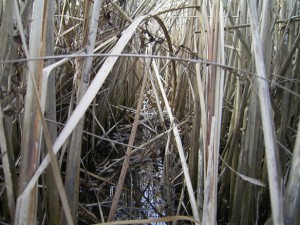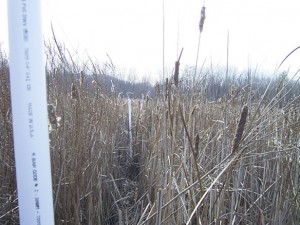Master’s Research
Freshwater marshes are among the most biologically productive ecosystems on earth, with annual aboveground primary production typically exceeding > 2 kg dry mass m-2 yr-1. Emergent vascular plants, such as Typha sp. (cattails) and Phragmites sp. (reed), often comprise a significant portion of the plant biomass produced on an annual basis. These wetland plants typically form dense stands within freshwater marshes and as a consequence may often function as important atmospheric carbon sinks. Furthermore, emergent plants with a high potential for growth can also absorb and store large amounts of nutrient pollutants (e.g., nitrogen and phosphorus) such that direct-plant assimilation is usually a predominant term used in many wetland nutrient budgets.
In wetlands, only a small of living plant biomass is used as a food resource by animal consumers since these plant tissues are not easily digested. Most of the plant biomass produced eventually enters the pool of decomposing plant matter, where microorganisms (i.e. bacteria and fungi) play an important role in its eventual breakdown and mineralization. Microbial carbon assimilation into biomass and CO2 mineralization may contribute considerably to wetland biogeochemical cycling and energy flow.
My study took place in a freshwater marsh ecosystem in southeast Michigan. Project goals of my master’s research research included:
- Determining biomass changes within standing-dead shoots and benthic litter of a cattail species over an annual cycle
- Estimating fungal and bacterial biomass, production, and growth rates and total microbial respiration associated with collected plant litter
- Constructing a decomposition budget on an areal basis (g/m2) to summarize carbon flows to and through the fungal and bacterial assemblages associated with detrital shoots and benthic litter


